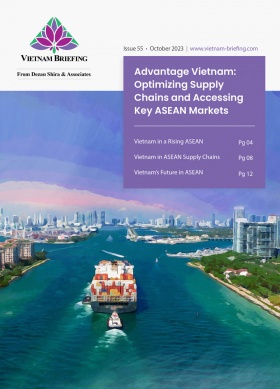Vietnam’s Warehouse Market: Foreign Investment Outlook
Vietnam’s warehouse market is rapidly expanding, driven by significant foreign investment and growing e-commerce demands. Concurrently, China’s warehouse developments near the Vietnam-China border are reshaping cross-border trade dynamics, intensifying competition for local and foreign players alike.
In recent years, Vietnam has solidified its position as a significant player in the global e-commerce arena, propelled by a rapidly growing online retail sector and rising consumer demand. Central to this expansion is a critical infrastructure component: modern warehouses. These facilities are essential not only for efficient storage and distribution but also for managing the complex logistics involved in cross-border trade.
As the e-commerce sector continues to grow, Vietnam’s warehouse market has undergone considerable transformation. As of the end of 2023, foreign developers have gained dominance in this market, leveraging substantial investments to reshape the landscape with advanced warehousing solutions that enhance logistics efficiency.
A significant development influencing this sector is the strategic construction of large-scale e-commerce warehouses by China near the Vietnam-China border. This initiative aims to strengthen cross-border trade and facilitate the seamless movement of goods between the two countries. China’s approach is indicative of a broader regional trend, with implications for both local and international market dynamics.
This article explores the current state of Vietnam’s modern warehouse market, the impact of Chinese warehouse developments on regional trade, and the future implications for warehousing and logistics in the country. By understanding these trends, stakeholders can better navigate the evolving landscape and seize emerging opportunities in e-commerce logistics.
Modern warehouse market in Vietnam
Vietnam’s modern warehouse market is experiencing notable expansion, driven largely by international investors. According to FiinGroup Vietnam, by the end of 2023, foreign entities controlled over 75 percent of the warehouse and factory rental space, significantly outpacing domestic companies with approximately 25 percent of the market. This dominance underscores the rapid growth and increasing importance of the warehousing sector within Vietnam’s logistics industry.
Sector growth and space utilization
Vietnam’s warehousing market has seen impressive growth, with the modern logistics sector utilizing about 3.9 million square meters of space as of late 2023. From 2020 to 2023, the sector achieved a remarkable annual growth rate of 23 percent.
This trend is expected to continue, with an anticipated annual growth rate of around 7 percent through 2027. This growth is driven by vigorous commercial, manufacturing, and retail activities, positioning warehousing as a key segment in Vietnam’s logistics infrastructure.
Geographical distribution
Modern logistics facilities in Vietnam are primarily concentrated in five major provinces: Binh Duong, Long An, Bac Ninh, Hung Yen, and Dong Nai. These regions are becoming hubs for warehousing and logistics, accommodating the expanding needs of the sector.
Foreign vs. domestic investment
Among the leading foreign investors, Mapletree, BW Industrial, and SLP together manage nearly 46 percent of the modern warehouse rental area.
In contrast, the top three domestic players—ICD ST, NPL Logistics, and Gemadept—control approximately 10.6 percent of the space. This disparity highlights the significant role of foreign investment in shaping the current market landscape.
Looking ahead, approximately 25 new warehouse projects are planned between now and 2027, adding around 1.87 million square meters of space. Key projects include:
- BW Industrial: A major development in Dong Nai province, offering 243,000 square meters by 2026.
- Mapletree: A new facility in Bac Ninh province, with 198,000 square meters planned for 2025.
Mapletree is also expanding its warehouse portfolio across Bac Ninh, Hung Yen, and Binh Duong, with each site consisting of 12 to 24 warehouses. Similarly, BW Industrial and NPL Logistics are increasing their holdings with 22 new warehouses across northern and southern Vietnam.
In response to rising demand and investment interest, local governments in Long An, Dong Nai, and Bac Giang are preparing to expand their industrial park areas. These expansions aim to attract further investments and support the sector’s growth.
Impact of Chinese warehouse development
China is significantly expanding its warehouse infrastructure near the Vietnam-China border, reflecting a strategic push to enhance cross-border e-commerce capabilities. The Chinese government’s recent policies prioritize the development of large-scale e-commerce warehouses in this region, with projects such as the China-ASEAN Cross-Border E-Commerce Industrial Park in Ha Khau and the Dong Hung Border Trade Zone in Guangxi.
These facilities are designed to bolster the efficiency and volume of cross-border trade, integrating advanced logistics, processing, and e-commerce functions within their operations. This expansion aims to create a streamlined logistics network, facilitating quicker and more cost-effective shipping processes for Chinese goods entering the Vietnamese market.
Implications for cross-border trade
The proliferation of these massive warehouses is set to revolutionize cross-border e-commerce by enabling faster delivery times and reducing logistical costs. With these new infrastructure developments, Chinese products can now reach Vietnamese consumers with unprecedented speed and efficiency, often matching or surpassing domestic delivery times.
This rapid transit capability could potentially enhance the market accessibility for Vietnamese exporters, allowing them to tap into new opportunities while offering consumers a broader range of products. However, it also introduces a competitive challenge as Chinese goods flood the market, posing potential hurdles for local businesses striving to compete on price and delivery speed.
Competitive landscape and market dynamics
The rise of extensive Chinese warehousing operations near the border is likely to intensify competition within Vietnam’s warehouse market. These developments could disrupt local and foreign competition dynamics, as the influx of low-cost Chinese goods and efficient logistics put pressure on domestic warehouses and e-commerce players.
For Vietnamese warehouse developers, this situation presents both opportunities and challenges. While there is potential to benefit from increased trade volume and investment in local warehousing infrastructure, there is also the risk of losing market share to more efficient and cost-effective Chinese counterparts.
Opportunities for foreign investors in Vietnam’s warehouse market
Vietnam’s logistics sector, particularly the warehousing market, presents promising opportunities for foreign investors due to the country’s rapid economic growth and strategic location in Southeast Asia. According to Article 4 of Decree 163/2017/ND-CP, foreign investors can engage in various logistics services, including warehousing, under specific conditions. For instance, foreign investors can establish or invest in companies providing container loading and unloading services or other warehousing-related activities with a capital share of up to 50 percent. This allows foreign entities to participate in and benefit from the expanding demand for efficient warehousing solutions in Vietnam.
Furthermore, the Vietnamese government is keen to attract foreign investment in logistics, including warehousing, to support the nation’s growing trade and economic activities. Foreign investors are permitted to form joint ventures, contribute capital, or purchase shares in local companies within the logistics sector.
With Vietnam’s favorable investment climate, modernizing infrastructure, and increasing trade volumes, there is significant potential for foreign investors to capitalize on the burgeoning warehousing market. By leveraging local partnerships and meeting regulatory requirements, investors can tap into Vietnam’s logistics sector and contribute to its dynamic growth trajectory.
About Us
Vietnam Briefing is published by Asia Briefing, a subsidiary of Dezan Shira & Associates. We produce material for foreign investors throughout Asia, including ASEAN, China, and India. For editorial matters, contact us here and for a complimentary subscription to our products, please click here. For assistance with investments into Vietnam, please contact us at vietnam@dezshira.com or visit us at www.dezshira.com.
Dezan Shira & Associates assists foreign investors throughout Asia from offices across the world, including in Hanoi, Ho Chi Minh City, and Da Nang. We also maintain offices or have alliance partners assisting foreign investors in China, Hong Kong SAR, Dubai (UAE), Indonesia, Singapore, Philippines, Malaysia, Thailand, Bangladesh, Italy, Germany, the United States, and Australia.
- Previous Article Vietnam Establishes National Steering Committee on Semiconductor Development
- Next Article Tourism Industry Prospects in Vietnam’s Kiên Giang Province








